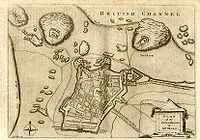Raid on St Malo
| Raid on St Malo | |||||||
|---|---|---|---|---|---|---|---|
| Part of Seven Years' War | |||||||
 Map of Saint Malo |
|||||||
|
|||||||
| Belligerents | |||||||
|
|
|
||||||
| Commanders and leaders | |||||||
|
|
|||||||
| Strength | |||||||
| 13,000 22 Ships of the line 8 Frigates |
|||||||
| Casualties and losses | |||||||
| light | 30 Privateers & 100 vessels burned | ||||||
The Raid on St Malo took place in June 1758 when an amphibious British naval expedition landed close to the French port of St Malo in Brittany. While the town itself was not attacked, as had been initially planned, the British destroyed large amounts of shipping before re-embarking a week later. The naval forces were under the command of Richard Howe while the army was led by the Duke of Marlborough and Lord Sackville.
As part of an effort to provide a diversion in support of Britain's German Allies, William Pitt had conceived the idea of a series of Naval Descents. In 1757 a large expedition was sent to Rochefort where it captured an offshore island, but failed to make an attack on the town itself before returning home. Pitt believed that the failure was due to insufficient vigour by the expedition's commanders, and planned to launch further expeditions against the French coast in the coming year.
By early 1758 the British cabinet planned the next raid and began to assemble a force on the Isle of Wight. Pitt had learned a number of lessons from the Rochefort expedition. New landing craft were designed, and the process of assembling the force improved to speed up the departure date. The selected destination of the expedition was St Malo, a fishing and privateer port on the Brittany coast - which would allow the force to remain in the English Channel so it could return home at short notice in case of a French invasion of Britain.
On 1 June the expedition sailed from England, reaching Cancale Bay near St Malo on 5 June. That evening the landing craft carrying the soldiers were put ashore. St Malo was situated at the end of a causeway, and it was hoped that the British could cut off the fresh water supply that ran along it. Once ashore the only immediate opposition they faced was a French artillery battery, which was subdued by the guns of the British warships. The troops then marched towards St Malo, but it soon became apparent they would need to conduct a full-scale siege to take the town - something they did not have the time to do. Instead the British occupied St Servan, a nearby port, and burned 30 privateers and 100 other vessels.
...
Wikipedia
